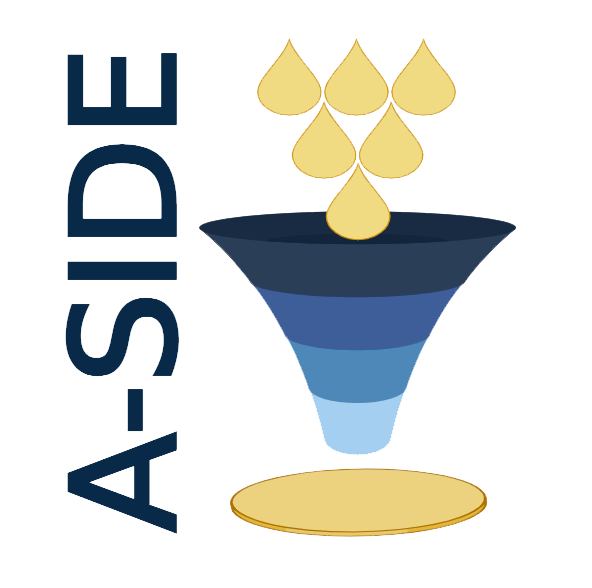A-SIDE

A bioengineered ocular insert that uses a patient's own serum proteins to treat dry eye disease with convenience, comfort, and efficacy.
- Severe dry eye disease significantly affects vision and quality of life for over 16 million adults in the US, and treatment options are ineffective for the majority of these patients.
- Autologous serum eye drops are a safe and effective alternative, with limited adoption due to poor shelf stability, and the need for repeat blood draws and frequent re-administration.
- We have developed a thin film-like ocular insert made of autologous serum (A-SIDE) that delivers the same therapeutic molecules while requiring fewer blood draws and only a single dose per day.
- Our preliminary data suggests that the A-SIDE technology will be less expensive to produce, shelf stable, and lead to better patient outcomes.
Dry eye disease (DED) is a chronic condition on the ocular surface that affects over 16 million adults in the US alone and its prevalence is expected to increase as the population ages. The costs of treating DED are staggering, with an estimate of nearly $4 billion in annual direct costs to the healthcare system.
DED is characterized by a failure to produce sufficient quality or volume of tears to maintain proper moisture of the ocular surface, leading to significant, negative effects on vision and quality of life. Patients suffer from relentless burning, irritation, and blurred vision. For chemical or thermal burns, graft versus host disease, and Stevens Johnson syndrome, this can mean the difference between sight and blindness.
Current treatment approaches include over-the-counter lubricants, artificial tears, lid hygiene, and identification/reduction of environmental triggers. When these options fail to control DED progression, prescription cyclosporine A (CsA) eyedrops are often the next line of treatment. Despite their widespread use, the overall efficacy of CsA eyedrops is considered suboptimal. For patients with a significant inflammatory component contributing to their DED, prescription lifitegrast is an option, yet not without serious ocular discomfort and limited applicability for many patients.
Autologous serum eye drops (ASEDs) are known to be more efficient than artificial tears with far fewer side effects than other drugs. However, clinical preparation requires multiple time-consuming steps and frequent patient visits to collect blood. The frequency of blood collection is due to the need to preserve biological activity of the growth factors in serum and prevent contamination. ASED therapy requires frequent drop instillation, every 2-3 hours for optimal results. Bottles are stored frozen until the day of use, refrigerated during that day, and disposed of at the end of the day.
We have developed an Autologous Serum Insert for Dry Eye (A-SIDE) capable of achieving the same level of protein delivery in one application as a daily course of ASEDs. This insert has a protein-rich serum layer (the “A” side) and a carboxymethylcellulose backing layer (the “B” side) which provides added comfort and prevents diffusion of proteins toward the eyelid. We hypothesize that the insert’s targeted transport of proteins to the ocular surface will lead to dramatically increased bioavailability.
Our current data suggests that A-SIDE would require 33% fewer blood draws, could be stored long-term at room temperature, and would be cheaper than bottled eye drops.
- Morgan DiLeo, PhD: Assistant Professor of Ophthalmology, Bioengineering and Clinical & Translational Sciences
- Vishal Jhanji, MD: Professor of Ophthalmology
The ultimate path to impact for the serum insert is commercialization and clinical use. We have carefully considered the ways this may be both disseminated and implemented. Fortunately, we have the support of the UPMC Eye Center and the Eye and Ear Foundation of Pittsburgh to share information about the development of the insert beyond the scientific community.
During the PInCh project period, we would set a goal of determining whether the inserts should be produced in the clinics or at an outside facility in a business-to-business model. We would analyze this from both a commercial and a regulatory perspective with the help of experts in those areas.
Additional funding can be obtained from many sources depending on our level of clinical translation. For example, a licensed startup company could be formed in order to apply for small business funding from the NIH or the DOD. We could also seek private funding for such a company. If we are not ready to license the technology, we have many options for translationally-focused grants in the vision research community, including the DOD Vision Research Program.
- How is the insert applied? We are developing a simple applicator to precisely place the thin insert beneath the lower eyelid. While it could be placed manually similar to placement of a contact lens (but without involving the nerve-filled corneal surface), the applicator will be cleaner and easier.
- How is the insert removed? It doesn’t need to be removed; both layers of the insert degrade over 24h and are completely gone before it’s time for a new A-SIDE.
- Will it be comfortable? A-SIDE is thinner than other products applied to the same space under the eyelid, and it contains comfort agents that lubricate the ocular surface as the bioactive serum proteins treat dry eye disease.
- How affordable will A-SIDE be compared to ASED therapy? ASED therapy costs $100 for an 8-12 week supply, and the A-SIDE will be cheaper because more inserts can be made per blood draw and packaging will be far less expensive.